

How to Prepare a PhD Research Plan/Schedule?
PhD research plan is a structured schedule for completing different objectives and milestones during a given timeframe. Scholars are usually unaware of it. Let us find out how to prepare it.
Between March 2021 to 2022, I read almost 15 different research proposals from students (for their projects) and only a single one, I found, with a comprehensive research plan for 3 years. Which is still not, kind of practical, probably copied from other students.
Such entities are not known to over 90% of students, if some know that because their university asked for but unfortunately, this basic procedure lacks penetration among students. I don’t know the exact reason, but students lack a basic understanding of the research process.
Meaning, that they don’t know or perhaps don’t complete their course work needly. PhD research requires many documents, SOPs and write-ups, before even starting it. For example, a rough research plan, research proposal, initial interview, competence screening, grant proposal and so on.
However, the requirement varies among universities and thus knowledge regarding basic procedures often also varies among students. So I’m not blaming students but certainly, it is the fault of the university side, as well.
When you come up with a research proposal with a research schedule or entire plant, certainly it will create a positive image and good reputation. So it is important. But how to prepare it?
Hey, there I’m Dr Tushar, a PhD tutor and coach. In this article, we will understand how we can prepare a structured plan for the PhD research and how to execute it.
So let’s get started.
How to prepare a PhD research plan/schedule?
A PhD research plan or schedule can be prepared using the GANTT chart which includes a month, semester or year-wise planning of the entire PhD research work.
First, enlist goals and objectives.
It’s not about your research objective enlisted in your proposal. I’m talking about the objectives of your PhD. Take a look at some of the objectives.
Note that these are all the objectives that should be completed during the PhD, but not limited to a specific subject. Note you have to show how you can complete or achieve each objective during the entire tenure of your work.
And that is what the plan/schedule is all about. Next, explain the time duration. The time required to complete each goal, roughly. For example, a semester or a year to complete the course work or 4 to 8 months for completion of ethical approval.
Now two things must be known to you, at this point in time.
- First, enlist the time required to complete each objective, as aforementioned.
- Second, what goals would you complete during each semester?
For instance, course work takes a semester to complete, but during the period a scholar can also craft their PhD research title, research proposal, ethical approval and grant proposals.
Now it is also crucial to know that there is no time bound to complete goals, but it should be completed as you explained. Let’s say you can plant it for 3 years, 4 or even 5 years depending on the weightage of your work.
In summary, the answer to the question of how to prepare a research plan is,
- Enlist your goals or objectives.
- Decide the time required to complete each goal.
- Prepare a GANTT chart.
Now you have prepared zero-date planning for your research but how to present it? The answer is a GANTT chart.
GANTT chart for PhD research plan:
GANTT chart is a task manager and graphical presentation of how and how many tasks are completed or should be completed against a given time duration. Take a look at the image below.
How can you prepare one?
Open MS Excel (on Windows) or numbers (on Mac).
Enlist goals or objectives in a column.
Enlist years (duration of PhD) in a row and bifurcate them into individual semesters. You can also prepare a month-wise plan, that’s totally up to you. In my opinion, semester-wise planning is good because research is a lengthy and time-consuming process. So monthly planning would not work.
To make a chart more attractive and readable use colors, as I used. Now mark a ‘cell’ against a column and row showing the objective which you are going to complete in a semester. Take a look.
After the end of this, your GANTT chart would look like this.
You can prepare a month-wise planning, individual semester-wise planning and goal-wise planning etc. I will explain these things in upcoming articles on 5 different types of GANTT charts for PhD.
Custom writing services:
If you find difficulties in preparing a research plan, synopsis, proposal or GANTT chart. We can work on behalf of you. Our costume services are,
- Synopsis writing
- Project writing
- Research proposal writing
- Research planning and GANTT chart preparation.
You can contact us at [email protected] or [email protected] to get more information.
Wrapping up:
Planning and executing a research schedule are two different things. Oftentimes, students just prepare as per the requirements and then do work as per their convenience. Then they are stuck in one place and just work around the time.
Plan things. Make your own GANTT chart, put it on your work table or stick it on a wall so that you can see it daily. Try to achieve each goal in time. Trust me things will work and you will complete your PhD before anyone else.

Dr. Tushar Chauhan is a Scientist, Blogger and Scientific-writer. He has completed PhD in Genetics. Dr. Chauhan is a PhD coach and tutor.
Share this:

- Share on Facebook
- Share on Twitter
- Share on Pinterest
- Share on Linkedin
- Share via Email
About The Author

Dr Tushar Chauhan
Related posts.

Why is it called a Doctor of Philosophy?

Preparing for a PhD Viva
Leave a comment cancel reply.
Your email address will not be published. Required fields are marked *
Save my name, email, and website in this browser for the next time I comment.
Notify me of follow-up comments by email.
Notify me of new posts by email.

UCL Ear Institute
- Typical timetable for full-time PhD student (3 ...

Typical timetable for full-time PhD student (3 Year)
Students and studentships.
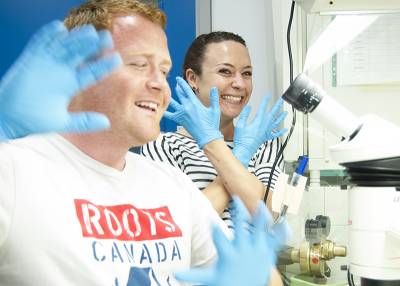
Find out what our current cohort of research students are getting up to, where our past students have ended up and whether we have any Studentships currently advertised on our jobs page:
- Current students
- Alumni testimonials
- Studentships (Jobs page)
- Resources for students/supervisors
- Skip to primary navigation
- Skip to content
- Skip to primary sidebar
Treseder Lab
Fungi, Ecosystems, and Global Change
Sample timeline for PhD students
April 25, 2015 by Kathleen K. Treseder

Read broadly and deeply in area of interest
Apply for fellowships and student-oriented grants
Develop plan for summer project (by April)
Perform field or lab project in summer
Develop idea for dissertation research and begin writing dissertation proposal (by December)
Complete formal literature review, meta-analysis, proof-of-method, or proof-of concept related to dissertation idea (by end of Spring Quarter)
Submit manuscript from above study (by end of summer)
Submit dissertation proposal to committee (by end of September)
Advance to Candidacy (by end of October)
Submit NSF DDIG proposal (October)
Perform field or lab research
Submit manuscript for completed lab or field work (by end of summer)
Complete remaining field and lab work
Apply for postdoctoral positions and funding
Finish writing dissertation
Defend dissertation and submit final version to UCI (by end of Spring Quarter)
Submit manuscript for completed lab or field work
Reader Interactions
8 Rules to write a PhD Thesis
Rule 4: make a phd timetable.
A PhD thesis can not be written in one week. Get this through your head. It is hard, maybe even the hardest thing you have to do during your PhD. It is going to be a painful task for most of you (it was for me). So schedule it in a proper time-wise manner. Do not wait until it’s just two weeks before the deadline to start writing. Here is a proposal: make a document with your PhD plan . Write down in that document the important things that need to be done in the last six months of your PhD, preferably in some chronological order. 3 Examples of things to write can be submission of papers, finishing data analyses or other leftover work, writing the thesis, preparing for the defence, sending some important emails, etc. Allocate at least two months of your time for the writing of the thesis . That’s a minimum proposed time frame and it might be far from ideal for you. Time equals money as they say, and that’s definitively the case for the PhD. So you might not want to spend too much of your time in thesis writing. On the other hand, you surely don’t want to underestimate the time that is required for such a colossal task. Therefore, you need to make a well-balanced estimate and plan your thesis writing accordingly. How can then someone derive such an estimate ?
For starters, you need to understand that the exact amount of time that is necessary to finish the thesis writing is hard to predict. The reason for this is that during such a large time period, your life is going to be influenced by a lot of factors. Some of these factors are uncontrollable and there is no way to prepare for them (the phenomenon also simply known as “ life happens ”). Some other factors are directly related to the practical task at hand and can thus be more easily predicted and regulated to your advantage. Using this knowledge, you can make a rough calculation of how much time it will take to write your PhD thesis. I personally think three factors are of significant importance to derive such an estimate. First, the format of the thesis , i.e. a paper-based thesis or a monograph, the latter of which will surely require more time to finish. Second, your personal writing speed , measured in the amount of chapters that you will be able to write on average in a specified time period (usually a week). Third, the number of chapters you need to write. Choosing the format of the thesis should be fairly obvious, based on common practices in your research field, the regulations of your academic institution and the existence or not of published PhD work (papers). Moreover, you should already have a pretty good estimate on the amount of total chapters, based on the modular way of constructing your PhD story as was explained in Rule 3 . Then all that is left, is for you to make an educated guess of your writing speed. The combination of the aforementioned three factors will then help you make a realistic estimation of how long the PhD thesis writing will take.
Let me share with you my personal experience on this matter. My thesis was paper-based. Following the rules in the section During writing , I was writing one to two thesis chapters per week. These were chapter drafts, so definitely not polished material. Therefore, my minimum writing speed was around one chapter per week . Continuing, I had a total of eight chapters to write + the abstract (derived from my initial story structure), which let’s say was equivalent to approximately nine chapters. Worst case scenario, I write one chapter per week, so a total of nine weeks are required. Best case scenario, I write two chapters per week, so a total of five weeks are required (rounding it up). Chapter size plays a huge role as you can probably guess. The proposed estimate of two months time is somewhere between five and nine weeks and closer to the second (the maximum of the two). So, eight weeks, equal to two months, sounded like a good deadline for my writing project. In the end, I finished the thesis writing in seven weeks, which was one week before the deadline. That included also reviewing the edits and comments from my supervisor and several rewrites. The important thing to remember here is that the calculation of your thesis time frame is going to be a personal rough estimate . Therefore, using an average writing speed of one chapter per week without further thought is justifiable (see Rule 7 on how to have more control over this). To summarize, my advice is to 1) calculate the number of chapters you are going to write 2) directly translate that number to weeks and 3) round it up to months. 4
Responsibly follow the time schedule you set up for yourself and be aware to not procrastinate on your thesis writing. This has also been stated more empirically as the notion that “ work expands to fill the time available for its completion ” (Parkinson’s Law). Procrastination can lead to unpleasant and stressful days before the thesis submission, that anyone would gladly dispense with. I have seen people doing rewrites, last minute additions, or otherwise work that could have been done a week or so ago, if properly scheduled. I have heard of people literally running to submit a printed copy in their respective department one hour before the deadline. Doesn’t sound too good to me. It’s a million times better to be prepared and follow your time plan religiously . Try to schedule your thesis writing in an anticipatory manner. This will happen when unfortunate scenarios that you can personally deal with, are managed to a satisfying degree. See also related discussion in the Epilogue .
Make a PhD timetable and allocate a realistic time frame for your thesis writing.
Of course you can make such a plan document from the start of your PhD. I just want to stress here the importance of including in this document what needs to be done during the last stages of your PhD. ↩︎
Remember to round up the resulting number to months! A basic arithmetic example is appropriate here. If you have a total of \(11\) chapters, the time required to write them down would be calculated as follows: \(\frac{11 \text{ chapters }}{1 \text{ chapter/week }}=11 \text{ weeks } \approx 12 \text{ weeks }\) (closest multiple of \(4\) ), which is equal to \(3\) months, assuming that \(1\) month is equal to \(4\) weeks. ↩︎
Understanding and solving intractable resource governance problems.
- In the Press
- Conferences and Talks
- Exploring models of electronic wastes governance in the United States and Mexico: Recycling, risk and environmental justice
- The Collaborative Resource Governance Lab (CoReGovLab)
- Water Conflicts in Mexico: A Multi-Method Approach
- Past projects
- Publications and scholarly output
- Research Interests
- Higher education and academia
- Public administration, public policy and public management research
- Research-oriented blog posts
- Stuff about research methods
- Research trajectory
- Publications
- Developing a Writing Practice
- Outlining Papers
- Publishing strategies
- Writing a book manuscript
- Writing a research paper, book chapter or dissertation/thesis chapter
- Everything Notebook
- Literature Reviews
- Note-Taking Techniques
- Organization and Time Management
- Planning Methods and Approaches
- Qualitative Methods, Qualitative Research, Qualitative Analysis
- Reading Notes of Books
- Reading Strategies
- Teaching Public Policy, Public Administration and Public Management
- My Reading Notes of Books on How to Write a Doctoral Dissertation/How to Conduct PhD Research
- Writing a Thesis (Undergraduate or Masters) or a Dissertation (PhD)
- Reading strategies for undergraduates
- Social Media in Academia
- Resources for Job Seekers in the Academic Market
- Writing Groups and Retreats
- Regional Development (Fall 2015)
- State and Local Government (Fall 2015)
- Public Policy Analysis (Fall 2016)
- Regional Development (Fall 2016)
- Public Policy Analysis (Fall 2018)
- Public Policy Analysis (Fall 2019)
- Public Policy Analysis (Spring 2016)
- POLI 351 Environmental Policy and Politics (Summer Session 2011)
- POLI 352 Comparative Politics of Public Policy (Term 2)
- POLI 375A Global Environmental Politics (Term 2)
- POLI 350A Public Policy (Term 2)
- POLI 351 Environmental Policy and Politics (Term 1)
- POLI 332 Latin American Environmental Politics (Term 2, Spring 2012)
- POLI 350A Public Policy (Term 1, Sep-Dec 2011)
- POLI 375A Global Environmental Politics (Term 1, Sep-Dec 2011)
Planning the timeline and progress of your doctoral dissertation (or Masters/undergraduate thesis)
One of my PhD students lamented this week with me that she had a lot to juggle (taking children to and from schools and to and from activities, etc.) and that she needed a strategy to make her research move forward. I had been planning to write this blog post for a while, since this is the one question I get asked the most by doctoral students (“ how do I plan my unstructured time over the summer ” being the other one).
Do you have one like this but for dissertations? From how to pick your topic to how to plan your chapters or something similar? 🙂 — Mariana Miguélez (@Scherezadda) March 27, 2018
I had to rush to get this blog post done because my student is 2 years away from the deadline her university has imposed for her thesis defence, which is why I sat down with her last night to show her how I do things. I have two other PhD students at exactly the same stage (2 years to defense) so I figured I might as well finish this blog post.
While I’ve suggested that people read one (or more) of the books that I’ve digested myself (check my Writing a Doctoral Dissertation page), one of the main things I teach my students is how to apply backcasting techniques to develop a project plan . I was trained as a project manager, and I worked in that capacity for a number of years, so I understand exactly the kind of work that needs to be done to develop good project plans.
There are a few resources for students, which I mentioned on Twitter earlier today (October 5th, 2018), many of which are listed in the thread that will appear if you click anywhere on the tweet shown below. Thanks to everyone who responded to my query, though I think many of them were professors describing their own process, which is not the same as having a doctoral dissertation (ONE GOAL) to finish in X number of years. My students are doing theirs in the 3 papers’ model, which is a bit closer to the day-to-day life of a professor, but still, the trajectory is quite different. Anyhow, here are some recommendations (click on the tweet to expand the entire thread).
Everyone: one of my PhD students today asked me how to plan her day/week/month/time table. Can you tweet me your process before I tweet/thread mine? Thanks! (I'm off to dinner because I've already written 460 words). — Dr Raul Pacheco-Vega (@raulpacheco) October 3, 2018
The core planning strategy I would thus recommend doctoral, masters and undergraduate students is to engage in a combination of Gantt Chart Design and project backcasting techniques .
The Gantt chart is a technique I learned in graduate school when I took project management courses. This is a hypothetical Gantt chart for my doctoral student, covering about 15 months.

What I suggested to her was to use backcasting techniques to plan backwards from her goal (PhD thesis defense) to intermediate goals. This post explains how I backcast a project https://t.co/wAmyejeoa0 since her dissertation is a 3-papers one, I suggested she uses that model. — Dr Raul Pacheco-Vega (@raulpacheco) October 5, 2018
For Gantt Chart templates, you can see Dr. Emma Sheppard’s here.
Project planning for research students https://t.co/ku7shfB5uL excellent template by @DrESheppard which may be of interest to students from undergrad, Masters and PhD levels. pic.twitter.com/ujQVlYocH7 — Dr Raul Pacheco-Vega (@raulpacheco) September 3, 2018
Here is another resource that you can use to create Gantt Charts.
To do Gantt charts you can use Excel or Microsoft Project (which is how I learned to do them), or Visio (which has been bought by the evil company and is now Microsoft Visio). I liked this detailed approach that uses connectors between milestones and tasks https://t.co/xVjNmM1q7c — Dr Raul Pacheco-Vega (@raulpacheco) October 5, 2018
Hugh Kearns and Maria Gardiner have lots of resources on their site, and have published books on this as well.
I just realised @ithinkwell and @ithinkwellHugh have excellent FREE templates on their website https://t.co/Q859jNiM6Q for PhD students to plan their trajectories, etc. #PhDChat (thanks, Maria and Hugh!) — Dr Raul Pacheco-Vega (@raulpacheco) October 5, 2018
Dr. Patrick Dunleavy’s book “ Authoring a PhD ” is incredible and really does help students who are planning their PhD process. I recommend it to my own doctoral students.
And of course I would be remiss if I forgot to recommend Dr. Ellie Mackin Roberts (my coauthor for a forthcoming book on research planning) and her website. Ellie has A TON of downloadable printables for you to plan your own research. She is fantastic.
Both for doctoral students AND for post-PhD folks, my coauthor Dr. @EllieMackin has an entire website for research planning https://t.co/unXMqmaf2Z she offers FREE downloadable printable templates that you can use to plan your own research. — Dr Raul Pacheco-Vega (@raulpacheco) October 5, 2018
In the end, the process I recommended to my students and that I do myself is – set a target defense date and then work backwards and plan tasks, activities, and intermediate goals. For example, I have asked my students to plan submission dates for their 3 papers (to be sent to journals) and then schedule fieldwork and data analysis accordingly. This process has worked well, and I hope my description of the process will help my students and others!
In a subsequent blog post I’ll describe how to go from long-term goals (submit paper X by Y date) to daily tasks. That blog post will definitely apply to doctoral students and post-PhD folks.
If you liked this blog post, you may also be interested in my Resources for Graduate Students page, and on my reading notes of books I’ve read on how to do a doctoral degree.
You can share this blog post on the following social networks by clicking on their icon.
Posted in academia .
No comments
By Raul Pacheco-Vega – October 6, 2018
0 Responses
Stay in touch with the conversation, subscribe to the RSS feed for comments on this post .
Leave a Reply Cancel Some HTML is OK
Name (required)
Email (required, but never shared)
or, reply to this post via trackback .
About Raul Pacheco-Vega, PhD
Find me online.
My Research Output
- Google Scholar Profile
- Academia.Edu
- ResearchGate
My Social Networks
- Polycentricity Network
Recent Posts
- “State-Sponsored Activism: Bureaucrats and Social Movements in Brazil” – Jessica Rich – my reading notes
- Reading Like a Writer – Francine Prose – my reading notes
- Using the Pacheco-Vega workflows and frameworks to write and/or revise a scholarly book
- On framing, the value of narrative and storytelling in scholarly research, and the importance of asking the “what is this a story of” question
- The Abstract Decomposition Matrix Technique to find a gap in the literature
Recent Comments
- Hazera on On framing, the value of narrative and storytelling in scholarly research, and the importance of asking the “what is this a story of” question
- Kipi Fidelis on A sequential framework for teaching how to write good research questions
- Razib Paul on On framing, the value of narrative and storytelling in scholarly research, and the importance of asking the “what is this a story of” question
- Jonathan Wilcox on An improved version of the Drafts Review Matrix – responding to reviewers and editors’ comments
- Catherine Franz on What’s the difference between the Everything Notebook and the Commonplace Book?
Follow me on Twitter:
Proudly powered by WordPress and Carrington .
Carrington Theme by Crowd Favorite

How to Manage Your PhD Timeline for Smoother Research Completion
It’s finally happening! The university has sent you an acceptance letter for the PhD program you had applied to. Getting into a doctoral program is not an easy task, and the speculations around it of being one of the toughest courses can’t be denied either. However, despite it being a daunting journey, one can smoothly sail through by managing the PhD timeline smartly. So sit back and read this article to plan your Ph.D. research timeline in an effective and hassle-free manner.
Table of Contents
Why Should You Draw a Ph.D. Timeline?
A PhD journey is laid with several milestones that come as you proceed. Thus, drawing a timeline preemptively helps researchers stay away from the last-minute terror of submissions, presentations, committee meetings, viva, etc. Furthermore, creating a timeline and adhering to it makes you a better learner and instills discipline in you.
How to Begin with the PhD Timeline Planning?
While creating a well-structured timeline, you must ask these questions to yourself and to your supervisor:
- What are the important steps of a PhD program?
- How many projects do you have to work on?
- What are the technical milestones for developing a protocol?
- What are the risks associated?
What to Do Before Creating Your PhD Timeline?
Obtaining a doctoral degree is a process of completing of required credits, passing the qualification test for submitting a doctoral thesis, writing and submitting a thesis, and final viva voce.
Follow these steps as you create your PhD Timeline :
- Attend the program orientation to understand specific graduation requirements
- Make a list of technical events such as conferences, committee meetings, PhD viva voce , presentations, qualification examination, etc.
- Manage your PhD timeline term-wise or month-wise
- Make a list of events on priority-basis
Step-wise Guide to Create Your PhD Timeline
Let’s take a detailed look at the steps required for a PhD. It is important to know what each step entails and what the deadline is for each of it. Generally, all universities have strict graduation requirements. A doctoral student is expected to complete a minimum number of credits to qualify as a PhD candidate. However, in some cases, a master’s degree is required for the doctoral program, and if you have obtained a master’s degree, you may be awarded a doctoral degree only through a research course without taking additional credits.
Here are 8 major milestones of a PhD program:
Milestone 1: Through consultation with your advisor, check whether there are any special graduation requirements other than the university and department that you may have to complete as part of your program.
Milestone 2: The supervisory committee must be formed within one year of the doctoral program and must have at least one meeting to plan the successful conclusion of a research project. In addition to the advisor, at least two other university professors are required to be members of this committee. Doctoral students must receive advice on how the doctoral program is progressing through regular meetings of the committee.
Milestone 3: In the second year of the doctoral program, you must pass a comprehensive exam which is known as the PhD qualifying examination . It is an oral presentation and oral exam of approximately 2 hours in front of 6-7 professors, essentially including one non-university professor, members of the Supervisory/Supervisory Board, and two other professors from your university and your advisors. Upon passing this exam, the PhD student’s status changes to PhD candidate. This makes him/her eligible to receive the doctoral degree.
Milestone 4: After that, by presenting the thesis and participating in conferences, the doctoral student must conduct his doctoral research in-depth and be recognized for it.
Milestone 5: When the curriculum requirements are met, the deadline for completing the doctoral thesis is determined through consultation with the advisor, and this is approved by the guidance committee.
Milestone 6: As a prerequisite before appearing for PhD viva, discuss the completed thesis with your advisor and select PhD external examiners related to the research field.
Milestone 7: Once the external expert/s reviews and approves the value, logic, and results of the doctoral thesis, the doctoral office allows the PhD candidate to take the thesis defense as the next course. In this defense, PhD candidates must pass a 2.5-3-hour oral examination based on their thesis in front of the doctoral examination panel.
Milestone 8: After receiving approval from the attending professors on the doctoral examination panel, submitting the final thesis, and applying for the doctoral degree, you will finally graduate with your PhD degree.
To download the PhD Timeline Template, click here !
Key takeaways.
Don’t get discouraged when someone shares their anecdotes of surviving a cumbersome PhD journey. Everyone applying for a doctoral program meets obstacles along the way; however, setting a proper timeline and following it diligently will only make your journey smoother than the rest. Do your best in accordance with your conscience, your mission as a learning scholar, and the regulations of your university. Wishing you a successful academic life with this PhD timeline . Let us know how you plan to soar through your PhD in the comments section below.
Rate this article Cancel Reply
Your email address will not be published.

Enago Academy's Most Popular Articles

- Career Corner
- Trending Now
Recognizing the signs: A guide to overcoming academic burnout
As the sun set over the campus, casting long shadows through the library windows, Alex…

- Publishing Research
- Reporting Research
How to Optimize Your Research Process: A step-by-step guide
For researchers across disciplines, the path to uncovering novel findings and insights is often filled…

- Industry News
Breaking Barriers: Sony and Nature unveil “Women in Technology Award”
Sony Group Corporation and the prestigious scientific journal Nature have collaborated to launch the inaugural…

Achieving Research Excellence: Checklist for good research practices
Academia is built on the foundation of trustworthy and high-quality research, supported by the pillars…

- Promoting Research
Plain Language Summary — Communicating your research to bridge the academic-lay gap
Science can be complex, but does that mean it should not be accessible to the…
Unlocking the Power of Networking in Academic Conferences
Intersectionality in Academia: Dealing with diverse perspectives
Meritocracy and Diversity in Science: Increasing inclusivity in STEM education

Sign-up to read more
Subscribe for free to get unrestricted access to all our resources on research writing and academic publishing including:
- 2000+ blog articles
- 50+ Webinars
- 10+ Expert podcasts
- 50+ Infographics
- 10+ Checklists
- Research Guides
We hate spam too. We promise to protect your privacy and never spam you.
I am looking for Editing/ Proofreading services for my manuscript Tentative date of next journal submission:

As a researcher, what do you consider most when choosing an image manipulation detector?

How to Create and Use a Gantt Chart for PhD Studies

A Gantt chart is a common tool used in the project management field. It is used for schedule planning of a project and its tasks and activities. It shows the tasks, their start and end dates, and the duration needed to complete them.
A PhD is a project and may last from as few as three years to as long as six years depending on the university and department a student is enrolled in.
In order to successfully complete a PhD program, one needs to plan when each of the tasks will be completed from the word go. A Gantt chart is very useful in doing this.
A PhD student can create one comprehensive Gantt chart or several smaller Gantt charts for each of the major deliverables.
This article discusses a Gantt chart for a general PhD program that has both coursework and dissertation components.
Benefits of a Gantt chart for planning PhD studies
Steps involved in creating a gantt chart for phd studies, how to effectively use the phd gantt chart, final thoughts on the phd gantt chart.
Creating a Gantt chart at the beginning of PhD studies has the following benefits:
- It is easy to create. A student can use the traditional pen-and-paper method or existing digital tools or softwares to create a Gantt chart.
- It is easy to read. The visual presentation of the Gantt chart makes it easy for the student to read and know what is expected of him at any point in time.
- A Gantt chart makes it easy to monitor progress of PhD studies. The user can choose to use different colors for tasks that have already been completed, tasks that are close to completion, and tasks that require more time and effort to complete.
- It forms the basis for monthly, weekly, and daily planning of the PhD studies. Depending on how detailed a student wants to go in terms of planning, the Gantt chart comes in handy when writing out the monthly, weekly and even daily plans.
Step 1: List all the deliverables expected of your PhD program. In this example, the PhD program has the following requirements:
- Coursework, divided into 4 modules each lasting 2 weeks. All 4 modules need to be completed within the first year of study.
- A comprehensive written exam at the end of the fourth module.
- An oral exam once a student passes the written exam.
- Submission of a concept note.
- Submission of a research proposal once a student passes the oral exam.
- Writing a business management case study.
- Three journal papers.
- At least two conference papers.
- A dissertation.
Step 2: For each of the requirements listed above, note the start and end dates. For the above example, the PhD program lasts a minimum of 3 years and a maximum of 6 years. Assuming the minimum of 3 years (beginning January 2021), the activities’ start and end dates are as follows:
Step 3: Using the above information, create the Gantt chart using Microsoft Word, Powerpoint or Excel.
The following are useful resources for creating a Gantt chart using:
- Microsoft Powerpoint: https://www.youtube.com/watch?v=wp0vr6OkW8Y
- Microsoft Excel: https://www.youtube.com/watch?v=00s5efQWrgU&t=10s
- Microsoft Word: https://www.youtube.com/watch?v=F90RdA5X4G0
The Gantt chart created from the above data is shown below. The chart was created using Microsoft Powerpoint.

Step 4: Once the Gantt chart is complete, print it out and hang it on the wall of your study room/area. This serves as a constant reminder of the tasks that need to be done at any point in time, as well as of the progress that has been made so far.
The greatest strength in using the Gantt chart for PhD studies lies in its ability to help one plan ahead. Using the Gantt chart above as an example, the user can plan as follows:
- At the beginning of every month, look at what is required of you. For instance, the student above needs to complete module one of the coursework and at the same time start working on proposal writing.
The student can plan for module one in advance by going through the course structure and expected readings, and reading in advance before the start of the module so that he is able to follow and understand what is being taught. If there are pre- and post-module exams, the student can also prepare for them in advance.
Preliminary tasks for proposal writing can include: discussing your proposed topic with your supervisor, and searching for and quick review of literature to identify the gap that your topic will be addressing. All these can be done in the first month before the actual proposal writing starts.
- The Gantt chart can help you identify the skills that are required for the successful completion of your dissertation. For instance, the student above is expected to write a Business Management case study by June of year 2.
If the student does not have case study writing skills, he can start looking for courses that teach case study writing and complete them way before the deadline for the case study. Same case for skills such as preparing and writing a journal paper, writing a conference paper, data analysis using softwares such as Stata, SPSS, NVivo etc.
- The Gantt chart can help you plan for academic-related events such as conferences.
In the example provided above, the student is expected to attend two scientific conferences (in November of year 2 and March of year 3) and make presentations.
The student can start looking for conferences related to his field that are held during the proposed times and mark the key dates and requirements of the conferences (for instance, abstract submission deadlines, abstract submission guidelines, registration deadlines etc).
- The Gantt chart can help you create monthly and weekly plans for longer tasks such as proposal writing.
In the above sample Gantt chart, proposal writing and defense spans a period of 15 months. By March of the second year, the student is expected to defend his proposal. This may seem like such a long period of time but in reality it is not. This is because it is not the only task that the student will undertake during this period. As a result, it is easier to focus on the tasks at hand and forget about the tasks that seem to have adequate time.
Proposal writing is a daunting task and requires constant reading and updating. To ensure that the student submits his proposal in time, he can create monthly and weekly plans for the task. An example of monthly planning for the proposal writing is provided in the table below:
The monthly plan is based on assumptions, for instance, that the supervisor will review the document within the scheduled timeframe. This may or may not hold, depending on the supervisor.
It is therefore important to allow ample time for such factors that are out of your own control in order to ensure that the task is completed by the deadline.
The monthly plans can further be broken down into weekly (and even daily) plans, for instance:
- Number of papers to read per week (day).
- Number of words to write per week (day).
- How many citations and bibliographies to insert (update) every week (day).
- Number of additional articles to search and add to your library each week etc.
Each of these tasks contributes to the overall proposal writing and make the task completion easier and faster than waiting for the last few months to do it all at once.
A PhD is a medium- to long-term project depending on how long it takes to finish. It therefore requires effective and careful planning from the start of the program to ensure that each deliverable is completed within the stipulated time. The Gantt chart is an easy-to-create, and easy-to-use planning tool that can be used by all PhD students. Not only does it save the student time but it also gives him peace of mind knowing the progress of each and every task required.
Grace Njeri-Otieno
Grace Njeri-Otieno is a Kenyan, a wife, a mom, and currently a PhD student, among many other balls she juggles. She holds a Bachelors' and Masters' degrees in Economics and has more than 7 years' experience with an INGO. She was inspired to start this site so as to share the lessons learned throughout her PhD journey with other PhD students. Her vision for this site is "to become a go-to resource center for PhD students in all their spheres of learning."
Recent Content
SPSS Tutorial #12: Partial Correlation Analysis in SPSS
Partial correlation is almost similar to Pearson product-moment correlation only that it accounts for the influence of another variable, which is thought to be correlated with the two variables of...
SPSS Tutorial #11: Correlation Analysis in SPSS
In this post, I discuss what correlation is, the two most common types of correlation statistics used (Pearson and Spearman), and how to conduct correlation analysis in SPSS. What is correlation...
Creating awesome Gantt charts for your PhD timeline
It’s a common scenario: you have never heard about Gantt charts. Then, when writing a PhD application or planning your PhD timeline for the upcoming years, someone suggests: You should include a Gantt chart! No need to worry. Here is all you need to know about Gantt charts for your PhD timeline.
What are Gantt charts?
Why are gantt charts frequently used for phd timelines, what information is included in gantt charts for phd timelines, creating a phd timeline gantt chart in microsoft excel, creating a phd timeline gantt chart in microsoft powerpoint, creating a phd timeline gantt chart in a microsoft word, creating a phd timeline gantt chart with an online tool, best gantt chart template for phd timelines in microsoft excel, best gantt chart template for phd timelines in microsoft powerpoint, best gantt chart template for phd timelines in microsoft word, gantt chart phd timeline example in microsoft excel, gantt chart phd timeline example in microsoft powerpoint, gantt chart phd timeline example in microsoft word.
A Gantt chart is a visual representation of a project schedule and a widely used tool in project management.
Gantt charts belong to the family of bar charts. In a Gantt chart, bars depict different project tasks. The length of each bar is proportionate to the task duration and indicates both start and finish dates.
Gantt charts are named after Henry Gantt. He lived from 1861-1919 and developed these types of charts as part of his work as a management consultant.
A Grantt chart is a great way to provide an overview of project tasks, activities and milestones.
Gantt charts are frequently used to illustrate PhD timelines because doing a PhD essentially means creating, managing and implementing a project with many components over several years.
Therefore, Gantt charts are popular tools among (aspiring) PhD students.
They are often featured in PhD proposals: Through visual representations, Gantt charts help communicate milestones, plans and estimated task durations.
Furthermore, Gantt chart PhD timelines allow PhD students to track their progress. They can also help PhD students to stay on track with their work.
You may also like: How to develop an awesome PhD timeline step-by-step
Gantt charts can include all kind of information, based on the specific project they are focusing on. When it comes to Gantt chart PhD timelines, there are several elements that are commonly featured:
- Extensive PhD proposal/plan
- Data collection
- Experiments
- Data analysis
- Writing plan
- Publications
- Conferences
- Courses/Coursework
Of course, every PhD project is unique. This uniqueness should be reflected in your Gantt chart. For instance, your Gantt chart PhD timeline will look different if you write a PhD based on articles or if you write a monograph .
For a PhD based on published articles, different bars in a Gantt chart PhD timeline could for example represent individual papers. For a monograph, it may be smarter to focus on research stages.
How do you create a Gantt chart for your PhD timeline?
Unfortunately, creating a Gantt chart in Microsoft Excel is far from straightforward as Excel does not provide its own Gantt chart template.
You can create a table, turn it into a bar chart and manually edit it until it looks like a Gantt chart. If you have some experience with Excel, it is doable. Detailed instructions on the process can be found in this manual from Ablebits.com.
However, why go through all the hassle when you can simply download a template? You can use Microsoft’s own free Gantt project planner template and adjust it to your PhD project.
Manually creating a PhD timeline Gantt chart in PowerPoint is a bit easier than in Excel. Therefore, I will explain the process here.
First, you need to open a blank PowerPoint slide. Then click on Insert (1.), then Chart (2.). A popup will appear. Select Bar (3.) and finally select the Stacked Bar option (4).
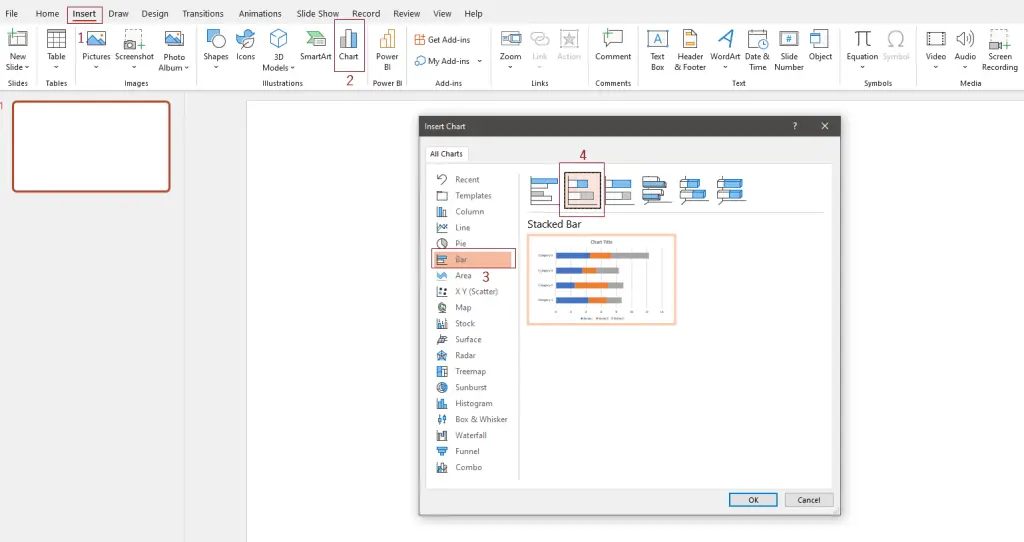
A standard bar chart will appear on your slide and a small Excel table with open next to it. The first column in the Excel table is called Categories . You can replace categories with the PhD tasks that you want to display. For instance, Literature Review, Interviews, Transcribing and Analysis. You can add more categories or delete existing ones by removing a row in the small Excel table.
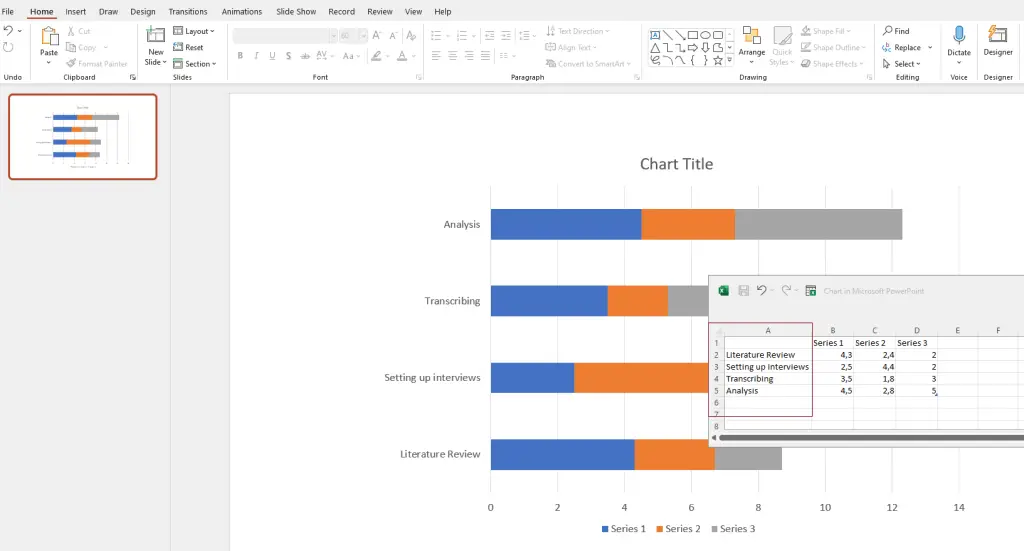
Next to the Categories (now tasks) column, you see three more columns: Series 1 , Series 2 , Series 3 . You can use these columns to showcase the length of tasks. Rename Series 1 into Start Date and Series 2 into End Date . Series 3 indicates the overall length. Depending on the timeframe you want to showcase, you can opt for instance for Length (weeks) or Length (months) .
In the example below, I decided to plan PhD tasks for a year. Thus, 1 means January, 2 means February, 3 means March and so forth. The length of tasks is also indicated in months:
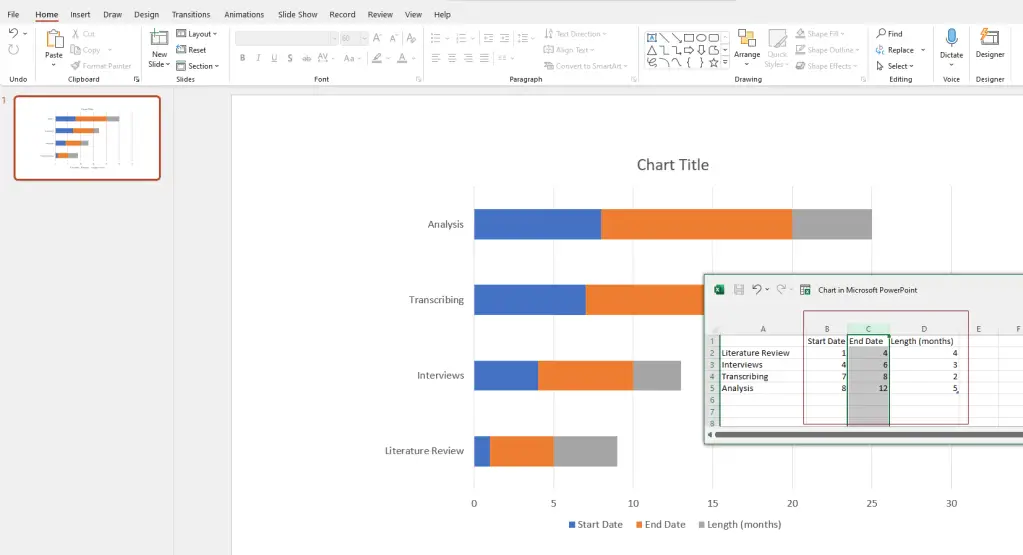
Next, click on your chart and three icons will appear in the upper-right corner next to it. Click on the bottom one, the Chart filters , remove the tick of the check box of End Date , and click on Apply. You will see that the bar chart will start to look like a Gantt chart:
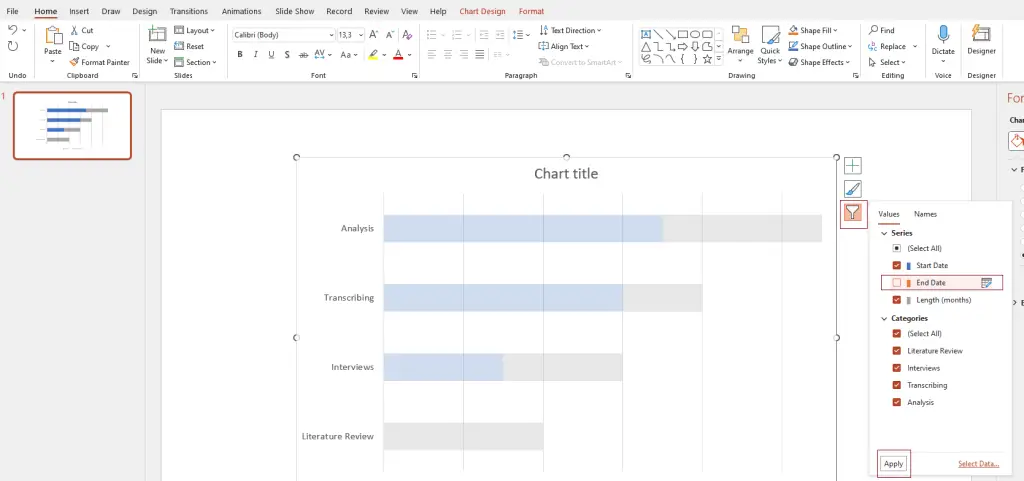
Now, the blue parts of the bar, indicating the Start Dates, need to be removed. Just click on one of them, and on the righthand side, Format Data Series should appear. Select No fill. Alternatively, in the upper menu, select Format , go to Shape fill, and select No fill .
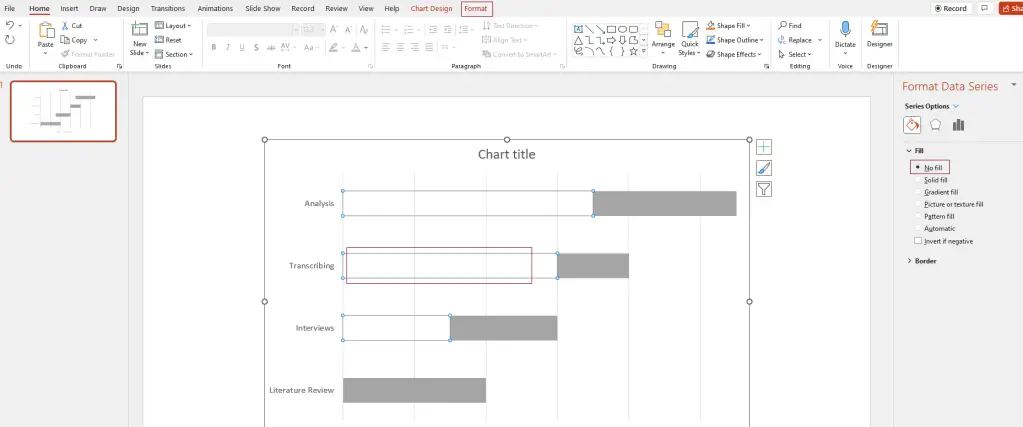
Now comes the fun part, namely decorating. You can add a chart title, colour the bars in the colour of your choice, edit the legend and the axis descriptions. Just play with it to explore the options.
One more thing I did was changing the value of the axis, because I want to illustrate the months of a year. Thus, it was a bit weird that the horizontal axis started with 0 and ended with 13 while I needed 1-12 to indicate each month of a year. You can simply change this by clicking on the axis. On the righthand side, Format Axis will appear. Go to Axis Options , Bounds , and enter 1 for Minimum and 12 for Maximum .
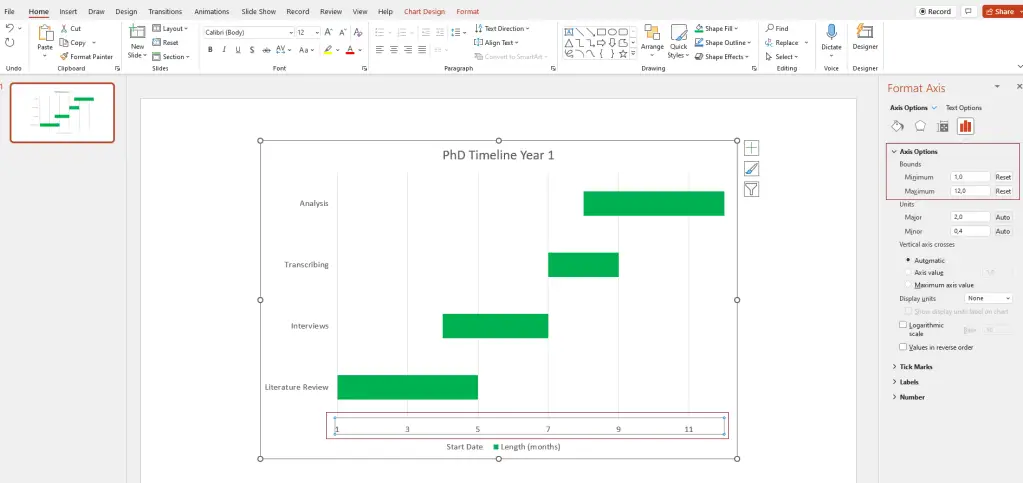
And voila! Your Gantt chart is ready.
The nice thing about learning how to create a Gantt chart in Microsoft PowerPoint is that you basically teaches you how to create one in a Word file as well! The process is very similar.
To start the process in Word, it is smart to first change the orientation of your page to Landscape . In the top menu, click on Layout , then select Orientation , then choose Landscape .
Next, select Insert , then Chart , and select a Stacked Bar chart again.
A basic bar chart will appear on your page:
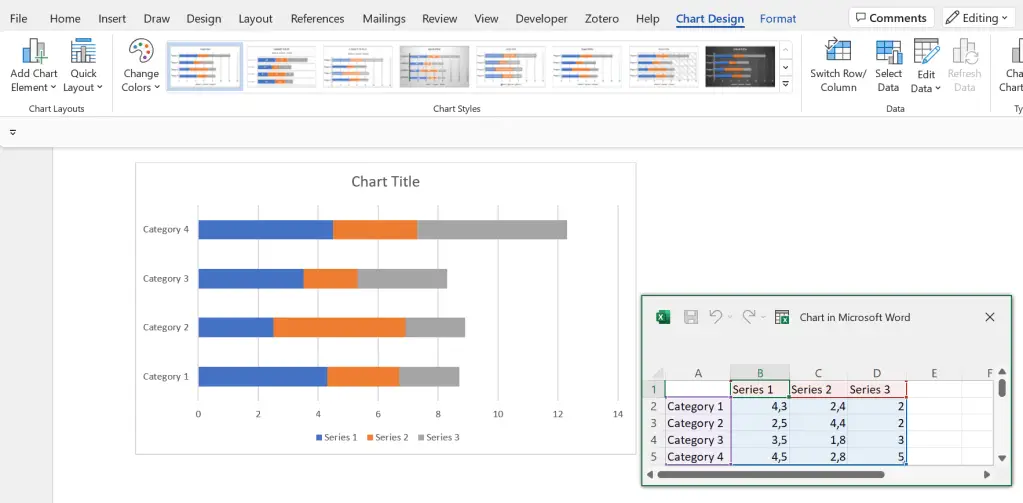
Looks familiar? Yes! From here, it is basically the same process as editing the bar chart in PowerPoint.
If you don’t want to go through the hassle of creating your own Gantt chart but are not convinced by any templates, you can make use of online tools and software.
There are some paid providers out there, but in my opinion, it is not worth paying to create an awesome PhD timeline.
You can use a free provider (or make do with one of the many Gantt chart templates that exist on the internet). One free online tool is the Free Online Gantt Chart Software :
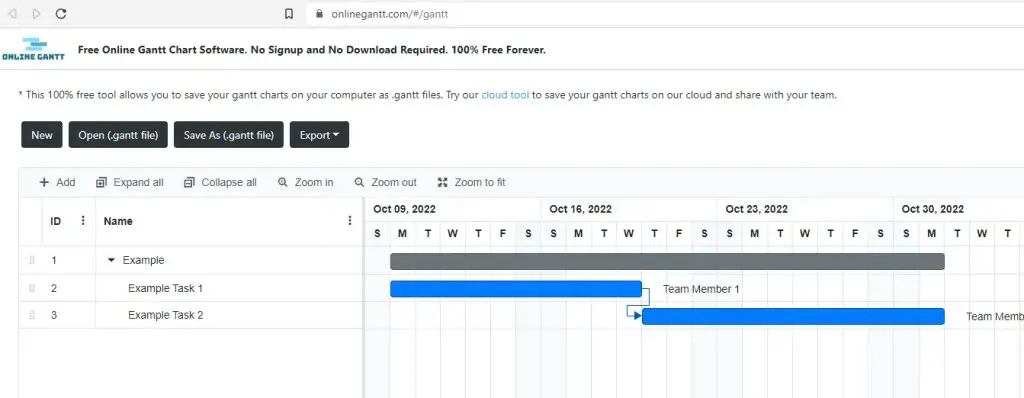
The site requires no signup. You can editing and simply start filling in the Gantt chart, and export it as an Excel, Image or PDF file when you are done!
PhD timeline Gantt chart templates
A great way to create a detailed Gantt chart in Microsoft Excel is by using Microsoft’s free Gantt project planner template . The level of detail and functionality exceeds those of simple, manually created Gantt charts. This makes this type of Gantt chart especially useful to track detailed PhD progress.
A useful Gantt chart template for PhD timelines in PowerPoint can be downloaded here via OfficeTimeline.com This Gantt chart is particularly great to provide a rough overview of plans over a longer period. For instance, with a few edits, you can illustrate a nice 3-year PhD timeline.
Useful Gantt chart templates for Microsoft Word can be downloaded here from TemplateLAB. I like these templates as they can be easily adjusted to the needs of a PhD timeline. For instance, a weekly Gantt chart template can be useful to establish a detailed plan with weekly objectives to keep your PhD progress on track.

PhD timeline Gantt chart examples
Using the template provided by Microsoft above, an example PhD timeline to track regular progress on tasks could look, for instance, like this:

Using the Gantt chart PowerPoint template by OfficeTimeline.com above, an example PhD timeline to present a plan for a 3 year PhD could look, for instance, like this:
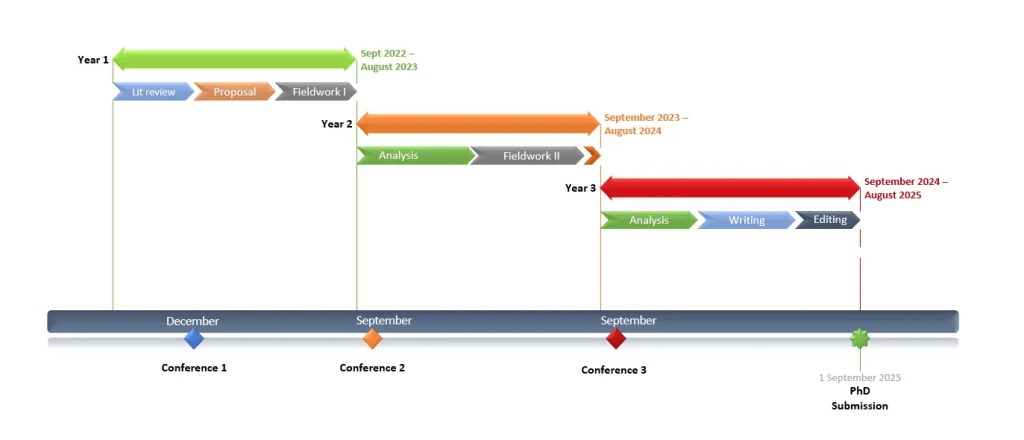
Using a weekly Gantt chart template from TemplateLab mentioned above, an example PhD timeline with weekly tasks and objectives could look, for instance, like this:
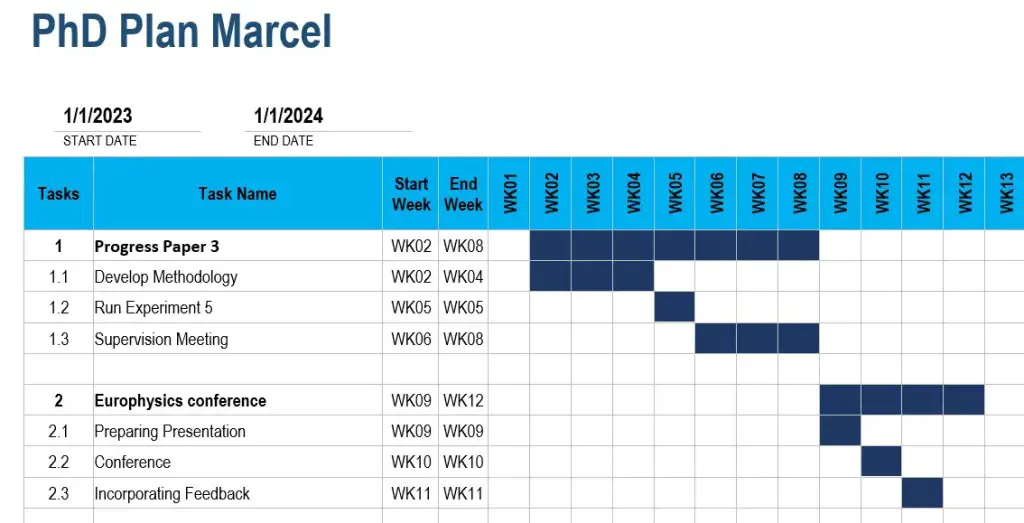
Master Academia
Get new content delivered directly to your inbox.
Subscribe and receive Master Academia's quarterly newsletter.
10 reasons NOT to do a master's degree
9 smart questions to ask a professor about graduate school, related articles.

The best way to cold emailing professors

10 key skills of successful master’s students

How to write a literature review introduction (+ examples)

How to structure your viva presentation (with examples)
Imperial College London Imperial College London
Latest news.

Analysis reveals new insights into global surge of Strep A infections

Imperial increases support for at-risk academics to continue their research

AquaBattery raises €6m in seed funding to deploy flow battery technology
- Department of Electrical and Electronic Engineering
- Faculty of Engineering
- Departments, institutes and centres
- Postgraduate research (PhD)
Timeline of a PhD
A typical PhD, taken over 3-4 years, is structured as follows:
First three months
During your first 3 months you settle in and prepare an initial research plan with your supervisor.
Your research plan gives a statement of the general topic area, an initial formulation of the issues to be addressed, a list of principal references on which the work will draw, and objectives for the first year of study. Your supervisor may also ask you to attend some of the undergraduate lectures.
You will also need register for the Graduate School's Professional Skills programme . If you are a non-native English speaker you will also have your English language ability assessed.
First six months
You can expect to spend your first 6 months undertaking literature searches and defining your project. You will have regular meetings with your supervisor. You will also meet the personal tutor (a member of staff from a different research group).
Months 7-18
You continue to work on your research project, and will have the opportunity to attend the Graduate School's Professional Skills courses on advanced writing, career planning, presentation and progressing.
An Early Stage Assessment is submitted by the end of month 9.
This report sets out the main research areas, details of work done so far, and a programme for future work. You attend an interview with one or two assessors and your supervisor. This assessment confirms your suitability to continue with your PhD programme.
You will have also attended some, or all of, the Graduate School's Professional Skills training on topics such as professional conduct, project management, and a residential course on research skills and development.
Months 18-24
Late stage review (22 months after registration).
You will be required to submit a report that contains the contents page for your thesis, a statement of expected contributions, achievements to date and a plan for completion of work and thesis. You will be assessed by interview with one or more assessors and your supervisor.
Months 24-36
You continue working on your research project. You will also have the opportunity to attend courses on career planning, and completing your research.
At the end of 36th month, you will complete a Progress Review, which will determine whether you will be moving up to the writing up status or maintain active registration.
Months 36-48
Progress Review ( at 36 months ). It is decided whether you should move to writting up stage or have your acitve registration extended.
Thesis submission ( by the end of 48th month )
Your thesis is your account of the work you have done, which should form a distinct contribution to the knowledge of the subject and show evidence of originality by the discovery of new facts and/or the exercise of independent critical power. The thesis is examined by an oral exam. There are two examiners: one from Imperial College and one from another university. The oral exam usually lasts for 2-3 hours, and you will find out the result immediately after the exam.
- Future Students
- Current Students
- Faculty/Staff

- Current Students Hub

Doctoral handbook
You are here
- Timetable for the Doctoral Degree
The Doctor of Philosophy degree at the GSE requires four to five years of full-time study. Possession of a relevant master’s degree may shorten this period. Per Stanford policy, students are required to enroll in each quarter of the academic year (Autumn, Winter, and Spring) from their first through final quarter in the program (i.e., until receipt of the degree). Approved leaves of absence are the only exception to this requirement. See the Registration and Student Statuses section of this Handbook and the GSE Courses section. Please note that although this timeline outlines the expected progress for doctoral students, students may always complete milestones earlier than what is outlined below.
- Enroll in Doctoral Core: Pro Seminar EDUC 325A (autumn), EDUC 325B (winter) and EDUC 325C (spring)
- Enroll in Methodology Core: EDUC 400A, EDUC 400B, EDUC 450A, and one additional methods course in consultation with an advisor
- Take any required area/subplan courses
- Take electives relevant to area and specialization
- Enroll in 11 to 18 units in the first three quarters of attendance
- Plan program of study in consultation with advisor(s)
- Assist in research and/or teaching
- First-Year Review in the spring quarter
Second Year
- Enroll in 8 to 10 units each quarter of the regular academic year (autumn, winter, and spring)
- Continue taking any required courses for area/subplan
- Finish methodology core if not completed during first year
- Second-Year Review in the spring quarter
- Finalize program of study in consultation with advisor(s)
- Transfer credit from outside institutions and/or choose a PhD Minor/Master’s Degree (recommended to be done by the end of second year, but can be completed anytime before the student goes TGR)
- Advance to candidacy
- Continuing taking required coursework and electives
- Enroll in 8 to 10 units each quarter of the regular academic year (autumn, winter, and spring quarters)
Fourth Year
- Complete 135 units of earned residency credit (including applicable transfer credit, if any)
- Select reading committee
- Apply for TGR status after completing all course-related degree requirements (including clearing any "incomplete" or "GNR" grades)
- Complete dissertation proposal hearing
- Note that going TGR and completing the dissertation proposal hearing are required in order to be eligible for the fifth-year funding guarantee
Fifth Year and Beyond
- Complete research for and write dissertation
- Schedule University Oral Examination (fourth or fifth year)
- Make revisions to dissertation after the Oral Examination
- Submit dissertation to the University (final quarter of program)
Each of these steps requires action and documentation by the student. At various times, the faculty advisor, Doctoral Programs Officer, Area Committee, or other entities participate in the completion of degree requirements. Students must ensure that each step is completed and that all appropriate parties have taken the necessary actions. See the Degree Progress Self-Tracking Checklist at the end of this Handbook.
- Printer-friendly version
Handbook Contents
- Degree Requirements
- Degree Milestones
- Registration and Student Statuses
- Graduate Financial Support
- GSE Courses
- Curriculum Studies and Teacher Education (CTE)
- Developmental and Psychological Sciences (DAPS)
- Learning Sciences and Technology Design (LSTD)
- Race, Inequality, and Language in Education (RILE)
- Social Sciences, Humanities, and Interdisciplinary Policy Studies in Education (SHIPS)
- Contact Information
- Stanford University Honor Code
- Stanford University Fundamental Standard
- Doctoral Programs Degree Progress Checklist
- GSE Open Access Policies
PhD students, please contact

MA POLS and MA/PP students, please contact

EDS, ICE/IEPA, Individually Designed, LDT, MA/JD, MA/MBA students, please contact

Stanford Graduate School of Education
482 Galvez Mall Stanford, CA 94305-3096 Tel: (650) 723-2109
- Contact Admissions
- GSE Leadership
- Site Feedback
- Web Accessibility
- Career Resources
- Faculty Open Positions
- Explore Courses
- Academic Calendar
- Office of the Registrar
- Cubberley Library
- StanfordWho
- StanfordYou
Improving lives through learning

- Stanford Home
- Maps & Directions
- Search Stanford
- Emergency Info
- Terms of Use
- Non-Discrimination
- Accessibility
© Stanford University , Stanford , California 94305 .

A typical PhD student schedule [Free template download]
A PhD student’s schedule is very different to anything that people have experienced in undergraduate or masters level education. Depending on the country that you are doing your PhD in, you may have classes alongside your dedicated research time. It is likely that you will work many hours more than a typical full-time job and may have some other administrative or teaching duties alongside your research.
A typical PhD student schedule involves turning up to the Department between 8 AM and 9 PM, and performing research activities during the day such as reading, writing, analyzing and reporting on literature and experiments.
The schedule of a PhD student also changes depending on the culture in your research group. Some supervisors require PhD students to turn up 6 to 7 days a week and spend up to 12 hours a day doing research. In my experience, this is very rare but a horror story that often gets passed around.
Most PhD supervisors are much more moderate when it comes to the commitments of their students and this article will cover the typical PhD student schedule and what you can expect if you enter a PhD.
A typical PhD daily schedule
A typical PhD student’s daily schedule will vary depending on the subject area, supervisor, and stage of your PhD. However, there are some things that are done consistently throughout the process of a PhD.
Here is a typical daily schedule of a PhD student.
The above timetable can also include:
- teaching activities
- group meetings
- departmental meetings
- other administrative tasks
- training, and much more
There are so many facets to a PhD students daily schedule that it changes almost every day depending on the demands of the research and the supervisor.
Here are some of the activities that a typical PhD student schedule contains. I have also looked at some of the specifics of different subject fields.
Common PhD student activities
A PhD is a training ground for academia.
Throughout a PhD, you will learn to perform the tasks of an academic such as reading literature, writing reports, analysing data, reporting and communicating your results, and presenting or attending different scientific talks and presentations.

Reading is the cornerstone of a PhD.
Learning to find the appropriate literature for your research and coming up with a method for reading, taking notes, and synthesising conclusions will be what sets out the top 10% of PhD students from the rest.
Many PhD students forget to set aside enough time for reading and it can severely impact their progress.
Reading wasn’t my favourite part of doing a PhD and I probably ignored it more than I should have. Nonetheless, ensuring you read regularly in and around your subject area will keep you up-to-date with the latest advancements in your field.
Supervisor meetings
Meeting regularly with your supervisor will keep your PhD on track.
Open communication between a PhD supervisor and the student ensures timely completion and help when things aren’t going so well.
My favourite frequency for supervisor meetings was fortnightly.
Every two weeks means I had enough time to plan, execute, and analyse data based on our previous meeting.
During supervisor meetings, you should share everything that has happened since the previous meeting. Importantly, you should share what has gone right, and wrong, and where you are going next. Head into supervisor meetings with solutions to problems and be sure to take criticism with an open mind.
Depending on your research area it may be more appropriate to meet up with your supervisor weekly to report your progress.
Writing during a PhD is often left until the last year but it is important to write regularly throughout your PhD.
Regular writing (even if it is just methods) will help you when you come to write your thesis or peer-reviewed paper.
During a PhD there are often different writing milestones that you need to achieve including:
- literature reviews
- conference abstracts
- technical reports for collaborators
- progress reports for grant funders
- peer review paper writing
- thesis or dissertation writing
As you can see, there are lots of different times when a PhD student will be set at their desk writing up results for a variety of audiences.
Formulating your own ideas and contributing to an academic field means analysing data and literature.
Many hours of PhD student time are dedicated to the analysis of other people’s ideas, data collected in the lab, and stress testing their own hypotheses.
Analysis is another cornerstone of a PhD.
Reporting your research findings is incredibly important. Communication is what keeps research rolling.
There are several ways that PhD students have to report their results. They may be reporting to their supervisor, collaborators, others in their field, all the general public.
One thing I loved about my PhD was the ability to communicate my research to a general and broad audience.
Writing reports, producing presentations, and writing performance reports for grant funding bodies are all important parts of a PhD student’s typical schedule.
Group/department meetings
After starting my PhD I was amazed at the amount of group and departmental meetings that I was expected to attend.
They seem to always be scheduled at a really inappropriate time and can cut your working day in half. Nonetheless, they are an important part of the PhD process.
Group meetings are for people in the same research group to share their findings and help each other with their work.
Departmental meetings may have an external presenter (from another university or Department) and so they must be well attended to give the appearance of an active and vibrant research community. You’ll get loads of emails reminding you about a meeting if there is a guest lecturer.
Topic-specific activities
Depending on the topic of your PhD you may have some other regular activities.
Humanities students will spend a fair amount of time in the library and reading academic texts. Looking for rare books, papers, and collections in the deepest darkest areas of the library are where you will find many humanity PhD’s.
Science, technology, engineering and maths PhD students will spend a lot of time performing experiments in a laboratory environment.
They will also help train masters and undergraduate students on particular instruments or techniques and be responsible for Occupational Health & Safety in the labs.
Because of the nature of a stem PhD, a science, technology, engineering or maths PhD student will spend many hours alone working in the depths of a university lab.
Social Sciences
Social sciences are likely to be conducting research using surveys or interviews and handling large amounts of data.
Making sure that they have ethical approval for their research can take a bit of time too.
Collecting enough data through questionnaires and surveys is always an issue for social science PhD students so they will be out collecting data as often as possible. They may have research assistants and undergraduates that can help them with their work.
Number of hours that PhD students work
There is no one answer to the number of hours that PhD students work. The number of hours is determined by the culture of the lab and the stage of the PhD.
On average a PhD student will work 40 – 60 hours per week.
Most will try to keep a regular 9 – 5 schedule whilst others will work when they are at their most productive. I know of one PhD student who would come into the lab at 5 PM and stay until one or two in the morning.
The great thing about doing a PhD is that you quite often get to choose your schedule. You may want to work early in the morning or late at night depending on when you feel most awake.
Also, you get to choose where you perform your PhD studies, as long as you do not need to be in a lab or present in the department.
What does a great PhD schedule look like?
A PhD student’s schedule can easily become unproductive if they go with the flow.
I believe that a strong daily schedule and commitment to at least two hours of focused work every single day will lead you to a much more rewarding and efficient.
I released a YouTube video that talks about the components of a failproof PhD daily schedule and you can watch it here:
I also include links to my daily schedule template that you can also get for free by clicking the image below:

Wrapping up
This article has been through everything you need to know about the typical PhD student schedule and how many hours you are expected to be in your office or department.
Having a frank conversation with your PhD supervisor will allow you to understand their expectations of their PhD students. It varies wildly from supervisor to supervisor – so it’s very good to be on the same page as soon as you start.
Remember to download my free daily schedule template to boost your productivity!

Dr Andrew Stapleton has a Masters and PhD in Chemistry from the UK and Australia. He has many years of research experience and has worked as a Postdoctoral Fellow and Associate at a number of Universities. Although having secured funding for his own research, he left academia to help others with his YouTube channel all about the inner workings of academia and how to make it work for you.
Thank you for visiting Academia Insider.
We are here to help you navigate Academia as painlessly as possible. We are supported by our readers and by visiting you are helping us earn a small amount through ads and affiliate revenue - Thank you!

2024 © Academia Insider
JCPS has two proposals to change school start times. Here’s what you need to know

In an effort to fix its transportation system , Jefferson County Public Schools is again changing some start times for the upcoming school year.
Board members are expected to vote May 7 on one of two scenarios for how start times could shift, according to district leaders. The first scenario would affect far fewer schools but result in less efficiency in bus routes compared to the second scenario, according to records obtained by The Courier Journal.
All schools not listed in either scenario will keep their current start time, aside from those currently at the 7:40 a.m. slot. Those schools will move to a 7:30 a.m. start time. The Brown School and Pathfinder will keep their 8 a.m. start times.
More: Does JCPS have a culture of fear and retaliation? What some employees and officials say
Here is what we know about the two scenarios.
This scenario would require close to 50 schools to change their start times — excluding those moving from 7:40 to 7:30.
According to a copy of a JCPS presentation obtained by The Courier Journal, this scenario would fix "major pain points" in the current transportation system and would increase the rate of students getting to and from school on time.
This plan, though, is not geographically based and will cause driver fatigue, according to the presentation. Additionally, only 20% to 30% of routes would be mirrored — meaning students ride the same bus with the same driver in the morning and afternoon — and students would get home later than if the board chooses the second scenario.
Schools with a 7:30 a.m. to 2:10 p.m. schedule:
- Camp Taylor
- Minor Daniels
- Breckenridge Metro
- Western Magnet
- Newcomer Academy
- The Phoenix School of Discovery
Schools with an 8:40 a.m. to 3:20 p.m. schedule:
- Carter Traditional
- Coleridge-Taylor Montessori
- Foster Traditional Academy
- Greathouse/Shryock
- Schaffner Traditional
- Waller-Williams Environmental
Schools with a 9:40 a.m. to 4:20 p.m. schedule:
- Coral Ridge
- Johnsontown Road
- Norton Commons
- Smyrna Traditional
The second scenario for how start times could shift would have a far greater impact on schools, but it would result in more benefits for the district's transportation system, according to a JCPS presentation.
Evening routes would end earlier, students would get to and from school on time more frequently, 50% to 60% of routes would be mirrored and drivers would be in geographical regions, meaning less fatigue. This also, according to the presentation, answers many of the school division leaders' requests for changes.
Under this plan, these schools would see significant shifts in their start times.
- McFerran Prep Academy
- The Academy @ Shawnee
- Thomas Jefferson
- Breckenridge Metro High
- The Acamdey @ Shawnee
- Western Magnet High
- Breckenridge-Franklin
- Jefferson County Traditional
- Moore Traditional
- Waller-Williams
- St. Matthews
- Zachary Taylor
- Olmstead Academy North
- Olmstead Academy South
- Election 2024
- Entertainment
- Newsletters
- Photography
- Personal Finance
- AP Investigations
- AP Buyline Personal Finance
- AP Buyline Shopping
- Press Releases
- Israel-Hamas War
- Russia-Ukraine War
- Global elections
- Asia Pacific
- Latin America
- Middle East
- Election Results
- Delegate Tracker
- AP & Elections
- Auto Racing
- 2024 Paris Olympic Games
- Movie reviews
- Book reviews
- Personal finance
- Financial Markets
- Business Highlights
- Financial wellness
- Artificial Intelligence
- Social Media
US poised to ease restrictions on marijuana in historic shift, but it’ll remain controlled substance
The U.S. Drug Enforcement Administration will move to reclassify marijuana as a less dangerous drug, a historic shift to generations of American drug policy that could have wide ripple effects across the country.
FILE - In this Friday, March 22, 2019, file photo, a marijuana plant is visible at Compassionate Care Foundation’s medical marijuana dispensary in Egg Harbor Township, N.J. The U.S. Drug Enforcement Administration will move to reclassify marijuana as a less dangerous drug, a historic shift to generations of American drug policy that could have wide ripple-effects across the country. The DEA’s proposal still must be reviewed by the White House Office of Management and Budget. (AP Photo/Julio Cortez, File)
- Copy Link copied
WASHINGTON (AP) — The U.S. Drug Enforcement Administration will move to reclassify marijuana as a less dangerous drug, The Associated Press has learned, a historic shift to generations of American drug policy that could have wide ripple effects across the country.
The proposal, which still must be reviewed by the White House Office of Management and Budget, would recognize the medical uses of cannabis and acknowledge it has less potential for abuse than some of the nation’s most dangerous drugs. However, it would not legalize marijuana outright for recreational use.
The agency’s move, confirmed to the AP on Tuesday by five people familiar with the matter who spoke on the condition of anonymity to discuss the sensitive regulatory review, clears the last significant regulatory hurdle before the agency’s biggest policy change in more than 50 years can take effect.
Once OMB signs off, the DEA will take public comment on the plan to move marijuana from its current classification as a Schedule I drug, alongside heroin and LSD. It moves pot to Schedule III, alongside ketamine and some anabolic steroids, following a recommendation from the federal Health and Human Services Department. After the public comment period and a review by an administrative judge, the agency would eventually publish the final rule.
“Today, the Attorney General circulated a proposal to reclassify marijuana from Schedule I to Schedule III,” Justice Department director of public affairs Xochitl Hinojosa said in a statement. The DEA is a component of the Department of Justice. “Once published by the Federal Register, it will initiate a formal rulemaking process as prescribed by Congress in the Controlled Substances Act.”
Attorney General Merrick Garland’s signature throws the full weight of the Justice Department behind the move and appears to signal its importance to the Biden administration.
It comes after President Joe Biden called for a review of federal marijuana law in October 2022 and moved to pardon thousands of Americans convicted federally of simple possession of the drug. He has also called on governors and local leaders to take similar steps to erase marijuana convictions.
“Criminal records for marijuana use and possession have imposed needless barriers to employment, housing, and educational opportunities,” Biden said in December. “Too many lives have been upended because of our failed approach to marijuana. It’s time that we right these wrongs.”
The election year announcement could help Biden, a Democrat, boost flagging support, particularly among younger voters .
Biden and a growing number of lawmakers from both major political parties have been pushing for the DEA decision as marijuana has become increasingly decriminalized and accepted, particularly by younger people. A Gallup poll last fall found 70% of adults support legalization, the highest level yet recorded by the polling firm and more than double the roughly 30% who backed it in 2000.
The DEA didn’t respond to repeated requests for comment.
Schedule III drugs are still controlled substances and subject to rules and regulations, and people who traffic in them without permission could still face federal criminal prosecution.
Some critics argue the DEA shouldn’t change course on marijuana, saying rescheduling isn’t necessary and could lead to harmful side effects.
Jack Riley, a former deputy administrator of the DEA, said he had concerns about the proposed change because he thinks marijuana remains a possible “gateway drug,” one that may lead to the use of other drugs.
“But in terms of us getting clear to use our resources to combat other major drugs, that’s a positive,” Riley said, noting that fentanyl alone accounts for more than 100,000 deaths in the U.S. a year.
On the other end of the spectrum, others argue marijuana should be treated the way alcohol is.
“While this rescheduling announcement is a historic step forward, I remain strongly committed to continuing to work on legislation like the SAFER Banking Act as well as the Cannabis Administration and Opportunity Act, which federally deschedules cannabis by removing it from the Controlled Substances Act,” Senate Majority Leader Sen. Chuck Schumer of New York said in a statement. “Congress must do everything we can to end the federal prohibition on cannabis and address longstanding harms caused by the War on Drugs.”
Federal drug policy has lagged behind many states in recent years, with 38 having already legalized medical marijuana and 24 legalizing its recreational use .
That’s helped fuel fast growth in the marijuana industry, with an estimated worth of nearly $30 billion. Easing federal regulations could reduce the tax burden that can be 70% or more for businesses, according to industry groups. It could also make it easier to research marijuana, since it’s very difficult to conduct authorized clinical studies on Schedule I substances.
The immediate effect of rescheduling on the nation’s criminal justice system would likely be more muted, since federal prosecutions for simple possession have been fairly rare in recent years.
But loosening restrictions could carry a host of unintended consequences in the drug war and beyond.
Critics point out that as a Schedule III drug, marijuana would remain regulated by the DEA. That means the roughly 15,000 cannabis dispensaries in the U.S. would have to register with the DEA like regular pharmacies and fulfill strict reporting requirements, something that they are loath to do and that the DEA is ill equipped to handle.
Then there’s the United States’ international treaty obligations, chief among them the 1961 Single Convention on Narcotic Drugs, which requires the criminalization of cannabis. In 2016, during the Obama administration, the DEA cited the U.S.’ international obligations and the findings of a federal court of appeals in Washington in denying a similar request to reschedule marijuana.
Goodman reported from Miami, Mustian from New Orleans. AP writer Colleen Long contributed.

Biden administration plans to drastically change federal rules on marijuana
The Biden administration is poised to make a landmark change to the federal government's position on marijuana with a proposed plan that would no longer consider marijuana among the most dangerous and addictive substances .
In what would be the biggest change in marijuana policy the federal government has taken since pot was first outlawed, the Drug Enforcement Administration will take public comments on a plan to recategorize marijuana under the Controlled Substances Act, according to a source familiar with the process. The news was first reported by The Associated Press .
The Department of Justice will send its recommendation to reclassify marijuana from a Schedule I drug to a Schedule III drug to the White House Office of Management and Budget, according to the source, who was not authorized to speak publicly. The Justice Department is expected to transmit the recommendation today, the source said.
More: Trucker failed drug test after taking CBD supplement. Supreme Court to decide if he can sue
The plan wouldn't legalize marijuana at the federal level outright, but it would reclassify it from a Schedule I drug – believed highly dangerous, addictive and without medical use – to a Schedule III drug that can be lawfully prescribed as medication. Marijuana has been a Schedule I drug since the Controlled Substances Act was signed in 1970.
“It is significant for these federal agencies, and the DEA and FDA in particular, to acknowledge publicly for the first time what many patients and advocates have known for decades: that cannabis is a safe and effective therapeutic agent for tens of millions of Americans," said Paul Armentano, deputy director of the National Organization for the Reform of Marijuana Laws, or NORML, which advocates for cannabis to be removed altogether from the list of controlled substances.
This bureaucratic move is only a small step toward what advocates hope will be full legalization of the drug. However, the new proposed classification does not fully address the inconsistencies between federal restrictions and the laws in a growing number of states that have authorized medical and recreational use of pot.
Twenty-four states and Washington, D.C., have legalized the recreational use of marijuana, and 14 other states authorize it for medical use, according to the Pew Research Center .
“Rescheduling the cannabis plant to Schedule III fails to adequately address this conflict, as existing state legalization laws – both adult use and medical – will continue to be in conflict with federal regulations, thereby perpetuating the existing divide between state and federal marijuana policies," Armentano said in a statement.
The federal proposal to reschedule marijuana would have broad support among voters. A nationwide survey last fall commissioned by the Coalition for Cannabis Scheduling Reform found nearly 60% of likely voters supported rescheduling, with 65% of younger voters 18 to 25 favoring it, the highest of any demographic group polled. Overall, the number of Americans who think marijuana should be legal reached a record high at 70%, according to a Gallup poll in the fall.
For decades, marijuana has been listed under the Controlled Substances Act as a Schedule I drug, alongside heroin, LSD and ecstasy. The act categorizes drugs based on their potential for abuse, addiction and medical use. Schedule I drugs are outlawed under federal law level and deemed to be without accepted medical use.
In 2022, President Joe Biden directed the Department of Health and Human Services to conduct a review of how marijuana is classified; and last year HHS recommended it be rescheduled to Schedule III, alongside drugs like Tylenol with codeine and anabolic steroids. The Justice Department did its own analysis and reached the same conclusion, the source said.
The proposal will undergo a public review period; the source did not say when the proposed rule would be open to public comment.
Rep. Andy Harris, R-Md., has previously criticized federal efforts to change Marijuana's classification . Harris was a physician at the Johns Hopkins Hospital, according to his online biography .
"Removing restrictions on an addictive gateway drug like Marijuana is a dangerous mistake. Numerous studies, including a recent and reputable study published by JAMA, points to the negative impact recreational marijuana has on the body and brain," Harris said in a Tuesday social media post on X, formerly known as Twitter.
Experts previously told USA TODAY that marijuana’s placement on Schedule I was not based on credible scientific evidence of its perils, but once it was listed, researchers and advocates faced a heavy burden trying to prove it shouldn’t face such stiff restrictions.
What exactly does rescheduling cannabis mean?
Placing marijuana in Schedule III puts it on par with drugs, such as ketamine, testosterone, anabolic steroids or Tylenol with codeine, that have “moderate to low potential for physical and psychological dependence,” according to the DEA.
Schedule III drugs can be legally prescribed by licensed health care providers and dispensed by licensed pharmacies. Rescheduling could also help resolve a massive federal tax burden that has been placed on cannabis companies – which were effectively seen as drug traffickers for tax purposes.
But rescheduling marijuana doesn’t make it legal to use recreationally, and it doesn’t change much about current state cannabis programs, said Jay Wexler, who teaches a seminar about marijuana laws at Boston University. It would still a controlled substance even with the new announcement
Wexler and other policy experts and advocates say rescheduling is not a solution, but it could be a sign the federal government is catching up with public opinion and consensus in the medical field that there are therapeutic benefits to marijuana, along with some risks.
"Rescheduling is a step forward, but it is not nearly enough. And there's no reason to keep cannabis in the Controlled Substances Act,” Wexler previously told USA TODAY.
What are the possible risks of marijuana?
Because of its classification, marijuana has been hard to study. But the move to reschedule marijuana is due in large part to its lower public health risk, federal scientists have said.
In a leaked HHS document , officials wrote to the DEA to support lowering its classification to Schedule III. Its risk for addiction was lower than other drugs and it had medical benefits, unlike Schedule I and II drugs, HHS researchers said.
Still, scientists said, users develop moderate to low physical dependence on it, and there is some risk of psychological dependence. However, they noted, the withdrawal symptoms are “relatively mild” compared with alcohol. Marijuana is more comparable to tobacco, they said.
There are no known deaths from a marijuana overdose, according to the National Institute on Drug Abuse , or NIDA. But it does affect physical and mental health.
Marijuana can cause permanent IQ loss for people who begin using it at a young age, the institute said. Additionally, long-term use has been associated with temporary paranoia and hallucinations, and it can exacerbate symptoms with disorders such as schizophrenia, NIDA said.
Marijuana smoke has a similar health impact to tobacco smoke. NIDA found people who smoke marijuana frequently develop issues with breathing, akin to tobacco smokers.
Smoking cannabis, the most common way to consume the drug, may have additional risks because of particulate matter a person inhales, according to a recent study in the Journal of the American Heart Association . Researchers noted cannabis smoke isn’t all that different than tobacco smoke, the only difference being the added effect of the psychoactive drug THC in marijuana rather than nicotine in tobacco.
Respiratory issues include daily cough, phlegm and a higher risk of lung infections, however, the institute said it’s unclear if marijuana causes a greater risk of lung cancer.
Smoking marijuana also increases heart rate, which can increase the chance of heart attack, especially among older people and people with heart conditions. The Heart Association journal study linked increased cannabis use with an increased risk of heart attack and stroke.
“Despite common use, little is known about the risks of cannabis use and, in particular, the cardiovascular disease risks,” the study’s lead author, Abra Jeffers, a data analyst at Boston’s Massachusetts General Hospital, said in a statement. “The perceptions of the harmfulness of smoking cannabis are decreasing, and people have not considered cannabis use dangerous to their health. However, previous research suggested that cannabis could be associated with cardiovascular disease.” She noted that smoking cannabis, which is the predominant way it is used, could pose other risks because it involves inhaling particulate matter.
In the study published in late February, researchers examined Centers for Disease Control and Prevention survey data of over 400,000 adults from 2016 to 2020, looking at self-reported cannabis use with cardiovascular outcomes, such as heart disease, heart attacks and strokes.
People who used marijuana daily had a 25% higher chance of having a heart attack and a 42% higher chance of stroke than those who didn’t use it at all.
Proposal reflects potential for health benefits
The cannabis plant has been used for medicinal purposes for centuries if not millennia. It appears to help with treating pain , insomnia, anxiety, and glaucoma, among other health conditions. Still, evidence is mixed and more research into its health benefits is needed, researchers at Johns Hopkins Bloomberg School of Public Health said in August.
While the FDA hasn’t approved the cannabis plant for any medical use, federal regulators have approved several drugs containing cannabinoids, or substances such as THC or CBD found in the cannabis plant, according to the National Institutes of Health .
These include Epidiolex, a purified form of CBD ingested orally, that is FDA-approved to treat seizures associated with two severe forms of epilepsy. Marinol and Syndros both contain synthetic THC and are used to treat nausea and vomiting caused by chemotherapy. Nabilone, another synthetic similar to THC, is approved as the brand name drug Cesamet for people with HIV/AIDS who experiencing weight loss and appetite loss.
A 2017 federal report found cannabis or cannabinoids were more likely to reduce pain symptoms for patients with chronic pain. Additionally, there is some evidence that cannabis is effective in treating symptoms of multiple sclerosis, particularly addressing the stiff or rigid muscles caused by the disease. One cannabinoid drug, nabiximol, a mouth spray that has both THC and CBD, has been approved in several countries but not in the U.S. Under the brand name Sativex, it has shown pain relief for people with cancer or multiple sclerosis.
Other research has examined cannabis’ uses to treat post-traumatic stress disorder, but the NIH said the evidence is mixed.

COMMENTS
Example: Planning year 2 of a 3-year PhD. Maria completed her first round of data collection according to plan, and starts the second year of her PhD with a lot of material. In her second year, she will focus on turning this data into two journal articles. Months 1-2: Maria works on her data analysis.
A PhD research plan or schedule can be prepared using the GANTT chart which includes a month, semester or year-wise planning of the entire PhD research work. First, enlist goals and objectives. It's not about your research objective enlisted in your proposal. I'm talking about the objectives of your PhD.
Research Proposal Outline: Develop a draft outline for your PhD proposal. Outline for proposal: Year 1, Q3: ... The key to a smooth and efficient doctoral journey lies in well-planned time management—a structured PhD timeline. This blog serves as an invaluable guide, offering detailed tips for planning out each academic year in both U.S. and ...
Transfer of registration from MPhil to PhD (between 9-18 months, but as. early as reasonable). 24 months: Submission and assessment of second year progress report on research log. Agreement of thesis structure and strict timetable. for thesis writing . 30 months (not less than 4 months before expected date of submission
A successful PhD journey begins with a solid plan that includes a PhD timeline. A thought-through and well-designed PhD timeline requires some time but can be accomplished in a few simple steps. Contents Why a clear PhD research timeline mattersStep 1: Decide what to include in your PhD timelineStep 2: Discuss your provisional PhD timeline
When writing your PhD proposal you need to show that your PhD is worth it, achievable, and that you have the ability to do it at your chosen university. With all of that in mind, let's take a closer look at each section of a standard PhD research proposal and the overall structure. 1. Front matter.
PhD timeline Author: Queensland University of Technology (QUT) Subject: Sample generic timeline for research higher degree students Keywords: PhD Milestones, Stage 2, confirmation, annual progress, final seminar, lodgement, thesis writing, research process, approvals, outputs. Created Date: 20100103233603Z
Year 3. Submit dissertation proposal to committee (by end of September) Advance to Candidacy (by end of October) Submit NSF DDIG proposal (October) Perform field or lab research. Submit manuscript for completed lab or field work (by end of summer)
Rule 4: Make a PhD timetable. A PhD thesis can not be written in one week. Get this through your head. It is hard, maybe even the hardest thing you have to do during your PhD. It is going to be a painful task for most of you (it was for me). So schedule it in a proper time-wise manner. Do not wait until it's just two weeks before the deadline ...
Therefore, in a good research proposal you will need to demonstrate two main things: 1. that you are capable of independent critical thinking and analysis. 2. that you are capable of communicating your ideas clearly. Applying for a PhD is like applying for a job, you are not applying for a taught programme.
Plan and monitor your PhD with a Gantt chart and include all of your activities in implementing Open Science practices to ensure efficiency and societal impact of your research work and efforts. This Gantt chart provides you with an example and template plan for your Ph.D. from thesis proposal writing to the thesis defense. Live spreadsheet ...
I have two other PhD students at exactly the same stage (2 years to defense) so I figured I might as well finish this blog post. While I've suggested that people read one (or more) of the books that I've digested myself (check my Writing a Doctoral Dissertation page), one of the main things I teach my students is how to apply backcasting ...
Written by Mark Bennett. You'll need to write a research proposal if you're submitting your own project plan as part of a PhD application. A good PhD proposal outlines the scope and significance of your topic and explains how you plan to research it. It's helpful to think about the proposal like this: if the rest of your application explains ...
Here are 8 major milestones of a PhD program: Milestone 1: Through consultation with your advisor, check whether there are any special graduation requirements other than the university and department that you may have to complete as part of your program. Milestone 2: The supervisory committee must be formed within one year of the doctoral ...
Prepare research proposal Research proposal/ethical approval submission Literature review Search, capture and synthesise relevant literature Notes and other output from the review process Prepare draft literature review Draft literature review section for final report Data collection Finalise sampling plan Sampling plan Develop data collection
How to Write a PhD Proposal. 1. Introduction. A PhD proposal is a focused document that int roduces your PhD study idea and seeks to. convince the reader that your idea is interesting, original ...
Research proposal examples. Writing a research proposal can be quite challenging, but a good starting point could be to look at some examples. We've included a few for you below. Example research proposal #1: "A Conceptual Framework for Scheduling Constraint Management".
Submission of a research proposal once a student passes the oral exam. Writing a business management case study. Three journal papers. At least two conference papers. A dissertation. Step 2: For each of the requirements listed above, note the start and end dates. For the above example, the PhD program lasts a minimum of 3 years and a maximum of ...
Manually creating a PhD timeline Gantt chart in PowerPoint is a bit easier than in Excel. Therefore, I will explain the process here. First, you need to open a blank PowerPoint slide. Then click on Insert (1.), then Chart (2.). A popup will appear.
Progress Review (at 36 months).It is decided whether you should move to writting up stage or have your acitve registration extended. Thesis submission (by the end of 48th month)Your thesis is your account of the work you have done, which should form a distinct contribution to the knowledge of the subject and show evidence of originality by the discovery of new facts and/or the exercise of ...
The Doctor of Philosophy degree at the GSE requires four to five years of full-time study. Possession of a relevant master's degree may shorten this period. Per Stanford policy, students are required to enroll in each quarter of the academic year (Autumn, Winter, and Spring) from their first through final quarter in the program (i.e., until receipt of the degree). Approved leaves of absence ...
A typical PhD student schedule involves turning up to the Department between 8 AM and 9 PM, and performing research activities during the day such as reading, writing, analyzing and reporting on literature and experiments. ... Many hours of PhD student time are dedicated to the analysis of other people's ideas, data collected in the lab, and ...
Step 1 -- rule out dates/times that are not possible. Start by sending an electronic-mail message asking for each person to summarise his/her availability during the relevant few months. This may not immediately elicit an obvious date or time, but allows you to rule out dates and times which are definitely not possible, thus sparing everybody ...
This mother delivered a baby and a PhD dissertation on the same day ... circulated a proposal to reclassify marijuana from Schedule I to Schedule III," Xochitl Hinojosa, the DOJ's director of ...
All schools not listed in either scenario will keep their current start time, aside from those currently at the 7:40 a.m. slot. Those schools will move to a 7:30 a.m. start time. The Brown School ...
WASHINGTON (AP) — The U.S. Drug Enforcement Administration will move to reclassify marijuana as a less dangerous drug, The Associated Press has learned, a historic shift to generations of American drug policy that could have wide ripple effects across the country. The proposal, which still must be reviewed by the White House Office of Management and Budget, would recognize the medical uses ...
The federal proposal to reschedule marijuana would have broad support among voters. A nationwide survey last fall commissioned by the Coalition for Cannabis Scheduling Reform found nearly 60% of ...